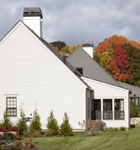At a Glance
Location
Rockford, IL
Founded
1951
Employees
75
Specialties
Construction and management of affordable housing
First, talk about how RHA has evolved.
Ron Clewer: RHA began as a traditional public-housing organization focused on providing safe, decent, affordable housing and resident services to promote self-sufficiency. But, recently, we’ve realized we need to alter our approach to make sure our properties are an asset to the community. From there, we’ve refocused our mission on fundamentally redefining affordable housing.
Can you give an example of this new focus?
RC: Our newest project, Jane’s Nobel Village, exemplifies our new direction. Built on a former public-housing site that was demolished, the $9 million development will feature 38 one- and two- bedroom units for the disabled. Construction began in winter 2011, and the master plan includes a central building with 16 apartments, surrounded by 22 units—which look like single-family homes—that replicate the historic architecture of the area. The units will feature efficient HVAC and water delivery among other green amenities such as transit-oriented design and a community vegetable garden.
A community garden?
RC: We view gardens as a type of support asset; they engage the residents in contributing to their community, bind neighbors together, and help them make quality food choices. Excess food will be sold at the local farmers markets, with proceeds benefiting our youth programs. The end result, we hope, will be healthier, more self-sufficient residents.
How do tenants with green thumbs contribute to your new mission?
RC: We want our existing and new communities to be true assets to the [larger] community. Elevating a development and its residents, rather than warehousing people in commercial-style housing, elevates the community as a whole. Adding amenities such as gardens and green improvements costs very little, but the return is immeasurable; the tenants are more invested, and the cost to operate is much lower.

What other initiatives are part of your strategic plan?
RC: The first two years of our current five-year plan were focused on streamlining our day-to-day operations, which generated an additional $600,000 annually to support our programs. Many of these programs are focused on helping residents break the cycle of poverty and dependency on public housing. Now, in our third year, we are looking at disposing of our more troubled housing assets, acquiring new assets, dedensifying developments, and renovating or rebuilding where necessary.
Can you talk more about your resident programs?
RC: Many of our residents lack jobs or are in a low-wage job. When they enter RHA housing, we work with them to assess their skills and then work over a period of time to help them develop those skills and become self-sufficient. Part of the process includes allowing them to save money, which can be used to build assets: i.e. purchase a home of their own. In spring 2012, we also launched ReBuild, a homegrown program that addresses more fundamental resident needs such as improving literacy and acquiring a GED.
Tell us about your Choice Neighborhood grant.
RC: We recently were awarded a grant from HUD, which will allow us to redesign and redevelop a neighborhood in need. We’ve chosen the Ellis Heights area, a very aged, functionally obsolete, densely populated area that is a sea of concrete and a haven for crime. For 18 months, we will brainstorm with public and private stakeholders about how we want the community to look, from education to housing to healthcare. We will then have six months to present a report to HUD about our vision. Then, we will seek grants and funds to implement the project.
Is funding a challenge for you?
RC: For all public-housing authorities, budgets continue to be a challenge as funding is reduced, so you have to be creative with ways to address costs. One thing we’ve done is contract out some of our day-to-day maintenance. For example, CCM & Associates, a local company, is a vendor we use for snow removal. You can save money outsourcing because you don’t have to purchase and maintain equipment. This example is just one way we’ve become more flexible and responsible. We’ve taken a different approach to our challenges, and it’s encouraging to look ahead and see how everything will come together, gain momentum, and lead us into a brighter future. ABQ


